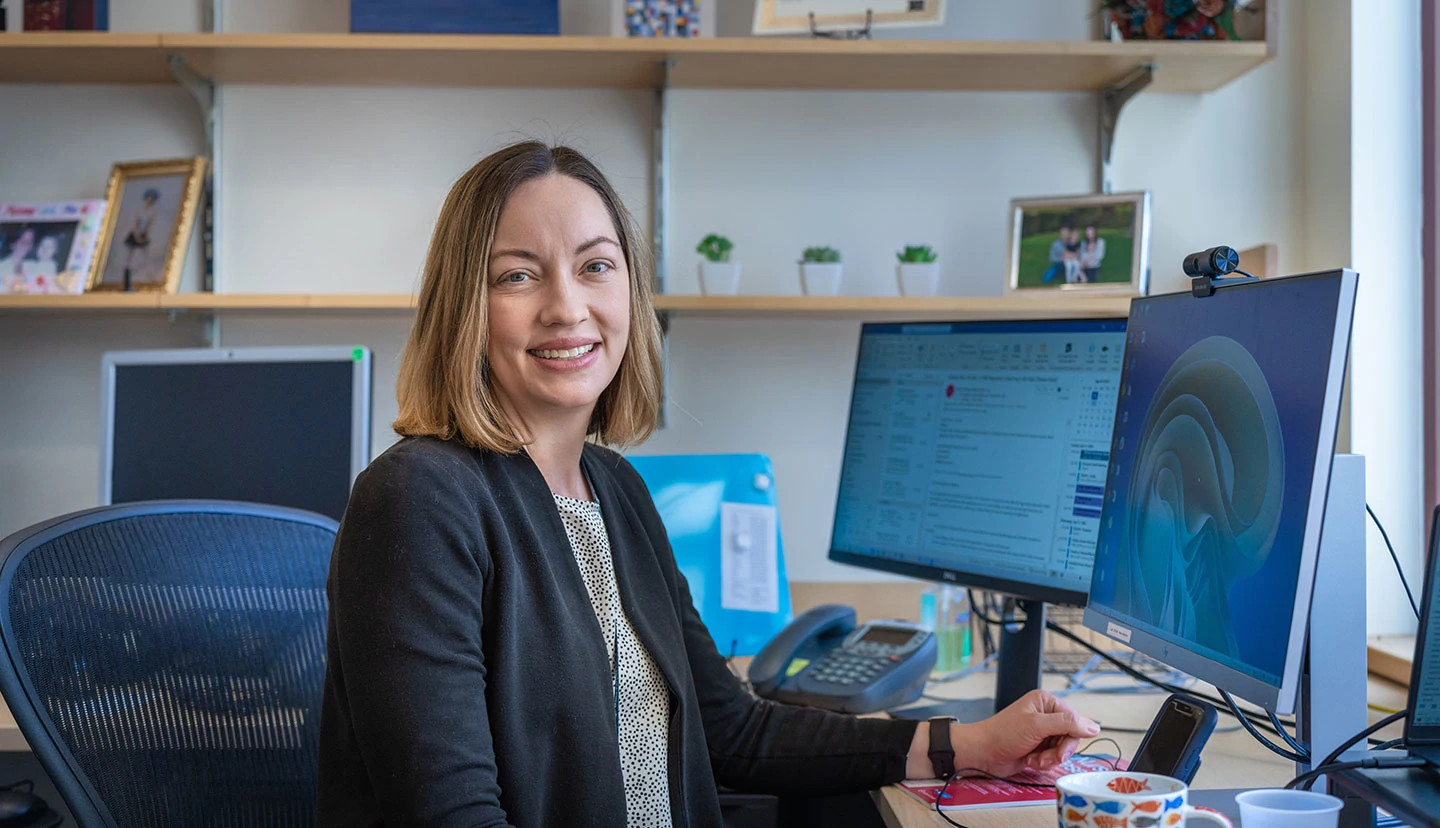
How Dana-Farber Researchers Are Helping Cancer Patients Get the Tools They Need to Lead Fulfilling Daily Lives
May 23, 2023
Inclusion, Diversity & Equity
Research
Chemotherapy
By Robert Levy
When Karen Maloney's ovarian cancer recurred in 2018, chemotherapy and PARP inhibitor drugs sent it into retreat. She was left, however, with a feeling of fatigue, a side effect of the PARP inhibitors. The fatigue varied in intensity but never went away, and likely wouldn't as long as she continued to take the drugs.
The Ashland, Mass., resident fought the fatigue by taking short walks or doing other forms of moderate exercise. But its impact on her life – on her ability to work a full day or take the long hikes she enjoyed – left her frustrated and angry. The energy spent resisting and resenting the fatigue was itself exhausting, she recalls.

When her Dana-Farber oncologist, Alexi Wright, MD, MPH, told her about a pilot study of a technique for coping with PARP inhibitor-related fatigue, she eagerly signed up.
The study, led by Dr. Wright, asked patients to re-examine their attitudes toward fatigue. Participants met weekly via teleconference with psychologists trained in Acceptance and Commitment Therapy, or ACT, which encourages people to recognize their thoughts and emotions rather than fighting or denying them. Patients also were coached on how to develop healthy sleep and exercise habits and use mindfulness techniques to ease their fears. Though the study involved a relatively small number of patients, the results were compelling.
"Patients who received ACT and wellness coaching reported reduced fatigue compared with those who did not receive ACT," says Dr. Wright, director of Gynecologic Oncology Outcomes Research in the Susan F. Smith Center for Women's Cancers. "Several women described the program as life-changing, remarking that it altered the way they lived with fatigue and that it lessened their anxiety."
Maloney joins in that assessment. "ACT emphasized coming to terms with the fatigue, viewing it as something neutral that I can live with and move beyond," she says. "Before the program, I'd felt I was staring at a wall of fatigue that was going to be in my life from then on. I learned to view it as a door that I could go through." Though she continues to feel fatigue from time to time, the skills she learned have eased some of its burden. "I'm doing things that I'd thought I wouldn't be able to do."
Redefining Outcomes for Cancer Patients
Maloney's experience encapsulates the purpose and promise of quality-of-life research. Like traditional clinical research, it is concerned with patients' response to treatment, the occurrence of side effects, and techniques for improving outcomes. Compared to traditional research, however, it has a more expansive conception of what constitutes an "outcome."
The terminology used by investigators underscores this difference. Clinical trial results are often expressed in terms of "survival" – how long patients live, on average, after a particular treatment or how long their disease is held in check. In quality-of-life studies, by contrast, the criterion is "life" in its fullest sense – how a treatment affects the patient as a whole. If a particular therapy is associated with peripheral neuropathy (weakness or numbness in the hands and feet), for example, a quality-of-life study might focus on the severity and duration of neuropathy, as well as its impact on patients' daily living.
The scope of quality-of-life research is as wide as the cancer experience itself. Studies may focus on the time of diagnosis, the treatment period, or the multiple stages of survivorship. The research examines the effects of cancer and cancer treatment on everything from a patient's relationships and work life to their mental health, finances, self-image, sense of independence, and plans for family, career, and retirement.
The field also has an unusually broad take on who and what are responsible for patients' well-being: In contrast to the classic view of treatment as the sole determinant of patient outcomes, quality-of-life research explores the role that clinicians, caregivers, and patients themselves can play in improving treatment results.
Helping Patients Identify What Matters Most
Quality-of-life research is a relative newcomer to the world of cancer science. Its rise is a consequence of the success of traditional clinical research.
When modern cancer medicine was young, in the first two-thirds of the 20th century, the overriding emphasis was on developing and testing treatments to lengthen patients' lives. As survival rates for many cancers have increased, and cures have arrived for some, research into how well patients live has gone from a secondary concern to a necessary one.
At the Susan F. Smith Center, Dr. Wright and her colleagues have led quality-of-life studies across the trajectory of cancer treatment. Their work has increased awareness of aspects of patients' experience that were long overlooked and has stirred new approaches to improving that experience.
When experts speak of personalized cancer medicine, they're usually referring to treatments that target the specific molecular features of a patient's cancer. For Dr. Wright and her colleagues who hope to expand that definition, it means care that accords with patients' values and priorities.
One study, dubbed the SHARE study, was designed "to help patients identify what really matters to them about the care they receive and to try to nudge them and their physicians to have conversations about that," Dr. Wright says. She joined Nancy Keating, MD, MPH, of Brigham and Women's Hospital, and a company called Healthwise, to create a video called "More Good Days" and a questionnaire to elicit patients' preferences of what constituted a good day for them. Patients were asked if they wanted more information about services at Dana-Farber, such as clinical trials and nutrition counseling, and if they would like help creating a legacy document – also known as an ethical will – that communicates one's experiences and life lessons to loved ones. After viewing the video and completing the questionnaire, patients were urged to share the results with their physicians.
"We found that many patients thought it was important to share this information their physicians – and about 40% did," Dr. Wright reports. "Unfortunately, many physicians didn't feel as strongly about its importance. We're working on ways to increase physician engagement."

Helping Patients Talk With Their Care Team
The benefits of good communication between patients and clinicians – and the difficulties that arise when it is lacking – can be far-reaching. As a postdoctoral fellow, Rachel Pozzar, PhD, RN, surveyed 176 patients with ovarian cancer about the quality of their interactions with their clinical care team and its broader effect on their well-being.
"Participants who rated their communication highly or viewed it as more patient-centered had better quality of life and lower symptom burden than those who rated it lower," says Dr. Pozzar, now an oncology nurse scientist in Dana-Farber's Phyllis F. Cantor Center for Research in Nursing and Patient Care Services. "In follow-up interviews, those who felt their clinical caregivers communicated well made comments such as, ‘I trust that my doctor has my best interests in mind and is looking out for me.' Those who didn't feel listened to, however, felt that more of the burden of care was placed on their own shoulders and that they had to advocate more for themselves. It placed an additional strain on being a patient with cancer."
The findings led her to ask whether communication could be improved by offering guidance to patients as well as clinicians regarding these conversations.
"We don't want to overburden clinicians, but we thought it could be helpful to provide brief reminders of how to respond empathetically to difficult questions or disclose information that might be hard to hear in a supportive way," Dr. Pozzar remarks. "Patients, for their part, may feel uncomfortable asking questions or not know what to ask. We're developing lists of questions that they can review before their visit, so they come in prepared."
Giving patients the opportunity to tell clinicians their concerns prior to an appointment can provide a head start on addressing those concerns. "In interviewing patients across the country, I heard comments like ‘I wish I had a therapist' or ‘I'm having relationship or intimacy problems,' or even practical matters like ‘I'm struggling with transportation' or ‘I'm worried about finances,'" Dr. Pozzar relates. "These are issues that can really impact a patient's quality of life, but a physician or nurse practitioner may not be the best person to address them."
To elicit patients' concerns and direct them to the proper specialist in advance of an appointment, Dr. Pozzar is developing an online tool. Sent to patients three days before a visit, it will enable them to identify concerns they want to address while they're at the Institute. These will be forwarded to the appropriate clinicians, while patients receive tips on discussing their concerns. Usability testing of the tool starts in 2023.
Helping Doctors Better Know Their Patients
For Dr. Wright, a quality-of-life study begins with the awareness of a gap in clinicians' knowledge of significant aspects of patients' experience. "My interest in this field arose from taking care of patients and noticing where we're missing information," she says. "We had treatments, we had procedures, but I didn't feel we were seeing the complete person."
One recent project grew out of her sense that clinicians didn't have a full picture of the difficulties patients face after undergoing certain procedures. "Patients and their family members often have to manage complex tasks at home. They may have a new ostomy bag [which collects waste from a surgical opening in the abdomen] or require TPN [intravenous nutrition that bypasses the gastrointestinal tract]," she relates. "They may have new tubes, lines, or drains, extending from their bodies that require a lot of care. My colleagues and I felt we didn't have a good understanding of how people adapted to these challenges."
The investigators surveyed patients about the changes they'd made in their lives. They used the responses to develop a program called BOLSTER (Building Out Lifelines for Safety, Trust, Empowerment, and Renewal) to help other patients who have undergone these procedures.
"We created a video series in which patients describe how they manage daily aspects of living," Dr. Wright says. "In one, for example, a woman with a colostomy explains how she changes the bag and how she goes through the security pat-down at the airport when she travels."
Along with the videos, investigators produced detailed educational materials for patients. During their first month after leaving the hospital, participants met weekly by videoconference with a nurse who guided and coached them through any difficulties they were facing.
The program was well received, Dr. Wright notes, by patients and family members, who were invited to watch the videos, read the educational materials, and attend the videoconferences. Investigators are currently adapting the program for Spanish-speaking patients.
Overcoming Unique Challenges to Pain Management
In its interest in patients as whole people, quality-of-life research embraces the whole of life, including its end. A particular focus of Wright's work has been pain management for patients with terminal cancer.

In a 2021 study, Wright and Dana-Farber colleague Andrea Enzinger, MD, published a study showing that as the country strove to stem an epidemic of opioid abuse, access to the medications had dropped sharply among patients dying of cancer. The study found evidence that tighter controls on opioids were increasingly driving terminally ill cancer patients to hospital emergency rooms for pain treatment.
"While the new restrictions are having the desired effect of reducing overall rates of opioid prescribing, our findings suggested that the changes were inadvertently depriving patients with advanced cancer of medicines they need to control their pain at the end of life," Dr. Wright relates.
Drs. Wright and Enzinger followed that study with one that explored whether the decline in opioid access was consistent across patients from different racial, ethnic, and socioeconomic groups. The results, published this year, made national headlines.
"We found that older Black and Hispanic patients with advanced cancer were less likely than white patients to receive opioid medications in the last weeks of life," Dr. Wright remarks. "The inequities were particularly stark for Black men, who were far less likely to be prescribed reasonable doses than white men were." The investigators also found that Black and Hispanic patients were more likely than white patients to undergo urine screening tests for drugs.
"We are planning follow-up studies to understand inequities in opioid access in different patient populations and at different phases of care, such as after surgery or during active cancer treatment," Dr. Enzinger says. "We are also planning some innovative analyses that look at patient-level, provider-level, and practice-level data to understand the key drivers of care inequities. These studies are critical so that we can intervene strategically and make the largest possible impact."